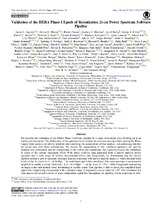| dc.identifier.citation | Aguirre, J.E., Murray, S.G., Pascua, R., Martinot, Z.E., Burba, J., Dillon, J.S., Jacobs, D.C., Kern, N.S., Kittiwisit, P., Kolopanis, M. and Lanman, A., 2022. Validation of the HERA Phase I epoch of reionization 21 cm power spectrum software pipeline. The Astrophysical Journal, 924(2), p.85. | en |
| dc.description.abstract | We describe the validation of the HERA Phase I software pipeline by a series of modular tests, building up to an
end-to-end simulation. The philosophy of this approach is to validate the software and algorithms used in the Phase
I upper-limit analysis on wholly synthetic data satisfying the assumptions of that analysis, not addressing whether
the actual data meet these assumptions. We discuss the organization of this validation approach, the specific
modular tests performed, and the construction of the end-to-end simulations. We explicitly discuss the limitations
in scope of the current simulation effort. With mock visibility data generated from a known analytic power
spectrum and a wide range of realistic instrumental effects and foregrounds, we demonstrate that the current
pipeline produces power spectrum estimates that are consistent with known analytic inputs to within thermal noise
levels (at the 2σ level) for k > 0.2h Mpc−1 for both bands and fields considered. Our input spectrum is intentionally
amplified to enable a strong “detection” at k ∼ 0.2 h Mpc−1 —at the level of ∼25σ—with foregrounds dominating on larger scales and thermal noise dominating at smaller scales. Our pipeline is able to detect this amplified input signal after suppressing foregrounds with a dynamic range (foreground to noise ratio) of 107. Our validation test suite uncovered several sources of scale-independent signal loss throughout the pipeline, whose amplitude is well characterized and accounted for in the final estimates. We conclude with a discussion of the steps required for the next round of data analysis. | en_US |

